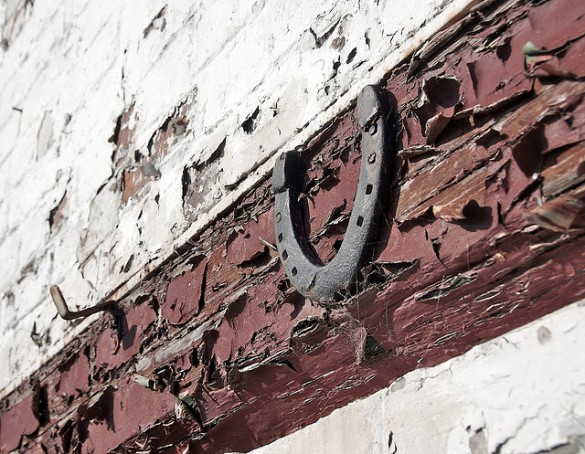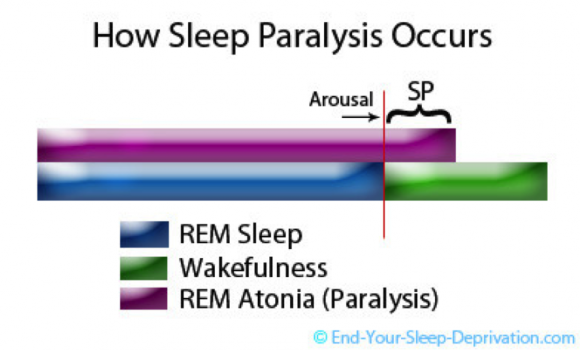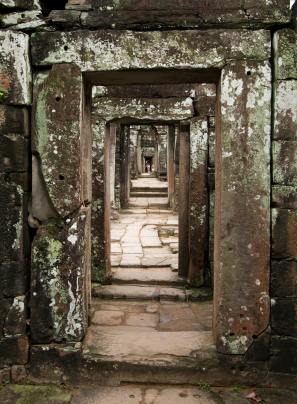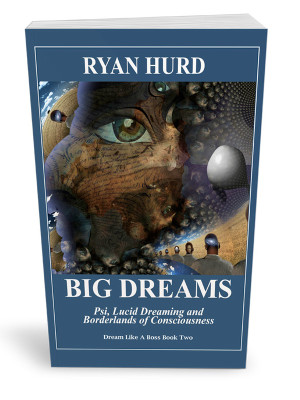
As most of my readers know, I have “suffered” from sleep paralysis night-mares since I was a teenager. I say suffer in quotes because these chilling episodes have also come to include some of my most transcendent experiences in the dreamworld: such as contact with healing light, benevolent angelic beings, and intense otherworldly journeys that have more in common with near death experiences than ordinary dreams.
One of the secrets to my ability to banish fear and move into some of these other altered states is my use of amulets and other sacred objects. It may reek of new-age sentimentality, but their presence has been very effective. These objects hold the space for me even though, during the daylight hours, my default worldview is the scientific materialism with which I was educated.
But the night demands a different kind of logic, an older cognitive strategy that is not so much superstitious as it is, um, completely appropriate to the task at hand: banishing those shadowy figures that hover in the doorway.
The Limits of Scientific Reasoning
Let me quickly re-establish what we know about sleep paralysis visions. These uncanny experiences occur at the threshold of sleep, when waking up or going to bed. The latest dominant theory, based on clinical EEG tests, suggests that sleep paralysis visions occur in Stage N-1 sleep, and may involve REM intrusion as well.

The REM theory has a certain appeal to it, as sleep paralysis visions have many of the hallmarks of REM dreaming cognition, such as vivid multi-modal imagery (all senses represented), high levels of negative emotion, especially fear, and high levels of sexual energy. Experiencers also report a quick and discerning level of self-awareness, resembling the upper potentials of lucid dreaming. Finally, the fact that you feel frozen, held down, or paralyzed appears to be an artifact of muscle atonia, a normal effect that happens to all of us when we are in REM sleep.
Other neurobiological considerations include a highly active amygdala, adding to the likelihood of fight/flight responses, and an out-of-whack vestibular system, giving way to sensations of floating, sinking, dissolving, as well as weird bodily distortions and transformations.
In sum, sleep paralysis sensations are completely natural, and not harmful from a biological perspective. Sleep paralysis can be considered being “stuck in the threshold” between wakefulness and dreaming. Mind awake, body asleep.
Unfortunately, none of this established scientific information is worth a damn when you are face to face with a toothy entity sitting on your chest.
By all means, try telling the demon-beast it’s a hallucination. They all have different reactions, but very few get their feelings hurt. Rather, for times like this, I am quickly reminded of the sacred objects surrounding my bedroom. (For a fuller treatment of how to get out of sleep paralysis, read this article). These objects empower me to stand my ground, practice compassion, or whatever it is that needs to be done without my boundaries being crossed.
Apotropaic Objects
Once we grant that sleep paralysis visions are essentially being struck in the threshold between waking and dreaming, the ancient art of apotropia becomes useful. Apotropia means “against fear,” and in the archaeology of belief, this term includes objects, rituals, and words that are used to protect against malevolent forces, seen and unseen.

It is no coincidence that apotropaic objects are historically-–and cross-culturally—placed in the threshold spaces of homes and structures: above lintels in door frames, under window sills, and inside chimneys and smoke holes.
This is because thresholds, those spaces between places, have their own magic. Paradoxically, openings into the home provide the ability to move freely and welcome guests, heat our dwellings, and let in the fresh air; at the same time, they open the home to unwanted guests, foul smells and harsh elements.
Anthropologist C. Augé Riley—an expert on the archaeology of belief—suggests that thresholds have a third dimension: liminality.
Supernatural forces arrive and congregate here in these spaces between, existing in a “temporal and spatial sector separate from mundane reality.”1
As Riley suggests, liminal zones are precisely where apotropaic agents are most effective.
Hence, people have always guarded their thresholds with magical items, objects imbued with personal and cultural significance, such as horseshoes, children’s shoes, sacred words, or iron crosses.
In sleep paralysis, this cognitive strategy is obvious. After all, many of our cultural narratives of the night visitors derive in part from personal experience in this vision state. Vampires and aliens hover in doorways, shadows slip in through windows, and ghostly apparitions flick and flutter on the periphery of our vision, as we struggle in paralysis, stuck in the threshold with our eyes open and a scream stuck in our throats.
Case study: Obsidian shows up
I’ve had objects keep vigil over me for years. But the connection between apotropaic objects and sleep paralysis reasserted itself inductively to me last month in a way I didn’t expect.
In the middle of the afternoon, I laid down on the futon in my office and fell into a light sleep.
 I then try to get up, and realize I am in paralysis. I roll off the couch, separating from my phenomenal body, and entering a lucid dream state. I find myself standing in an accurately portrayed version of the room, but my vision is cloudy. My eyes hurt too—deep in my ocular cavities. I look down and I am now holding a large triangular wedge of obsidian, or dark volcanic glass. Without thinking, I push the sharp obsidian edge into my eye area. It’s like inserting an old school Nintendo cartridge into the game player—there’s a perceived click when the obsidian is in place. The pain in my eyes stop and now I can see clearly, and feel that I am more fully here. I then flip my body backwards onto itself and the dreambody cancels itself out where it intersects, until I am bodiless in a dark spacious void…. (10/9/2012)
I then try to get up, and realize I am in paralysis. I roll off the couch, separating from my phenomenal body, and entering a lucid dream state. I find myself standing in an accurately portrayed version of the room, but my vision is cloudy. My eyes hurt too—deep in my ocular cavities. I look down and I am now holding a large triangular wedge of obsidian, or dark volcanic glass. Without thinking, I push the sharp obsidian edge into my eye area. It’s like inserting an old school Nintendo cartridge into the game player—there’s a perceived click when the obsidian is in place. The pain in my eyes stop and now I can see clearly, and feel that I am more fully here. I then flip my body backwards onto itself and the dreambody cancels itself out where it intersects, until I am bodiless in a dark spacious void…. (10/9/2012)
Upon awakening, I’m struck by how the obsidian spontaneously showed up. I then realize I actually have several pieces of obsidian in the room; they are in a bowl that I placed in one of the corners of the room months ago when we moved into the house. I hadn’t thought of them since. I picked up the obsidian from a natural source in California, and have used it for stone tool making. While I knew about obsidian’s reputation in some circles for absorbing negative energy, and have at times placed obsidian in a room purposefully, I have never used it ritualistically.
And I had never connected obsidian and SP. Aha, I think: the obsidian reveals itself as a true liminal object, traversing both the waking and dreamworld versions of my office. And more than that, the obsidian takes on a healing role, clarifying my vision and allowing me to move to the next arena in the dream without fear.

And that’s what we want to see: liminal objects that have a natural presence in both worlds. Which objects are best for these purposes is a matter of personal belief and tied to cultural traditions. Some cross cultural themes include animal bones and tendons, certain stones, iron, mirrors, and dried herbs at certain times of year.
I’m not necessarily saying that these objects are inherently magical. You cannot prove or disprove this line of reasoning in the waking world. Rather, I’m saying that we are probably neurologically primed to recognize objects with liminal properties, and that they are effective when applied in the correct states of consciousness.
Apotropaic ritual can also include prayer and affirmations, by the way. Ironically, these prayers, as I suggest in my book Sleep paralysis, can include fear-calming statements about the neurological origins of the predicament, such as “I’m in sleep paralysis right now; a natural state in which my body is still asleep because my muscles are paralyzed. There is nothing to fear.” However, these statements, I’ve found, are more effective at the beginning of SP, and not always so when full-contact visions have taken shape.
Finding amulets that work
Using amulets to protect yourself in sleep paralysis is an efficient cognitive strategy because the dreamworld is where magical thinking works. It’s the dominant logic, creating an increased fusion between subject/object that is rarely seen in the waking world.
The trick, of course, is finding the right objects. This is a very personal activity that one does not do while eating a piece of pizza and checking Facebook.
Look for clues in your own dreams: rocks of a certain color, objects from a certain place where you feel safe.
Look especially to your cultural traditions, even if you have rationally unsubscribed from the religious elements of that worldview.
Look to other traditions’ objects in which you feel a special affinity. You don’t want to culturally appropriate—taking on the culture as your own—but some objects can cross cultural boundaries. I recently spoke to a man with Jewish ancestry who said he is drawn to an iron cross for protection.
 Another case-in-point would be the ubiquitous dreamcatcher, originally from the Ojibwa Nation in the Great Plains. Craftspeople of many Native traditions now make dream catchers that are blessed and made specifically for use by non-Natives. (You definitely want to make sure your dreamcatcher wasn’t made in a factory in China).
Another case-in-point would be the ubiquitous dreamcatcher, originally from the Ojibwa Nation in the Great Plains. Craftspeople of many Native traditions now make dream catchers that are blessed and made specifically for use by non-Natives. (You definitely want to make sure your dreamcatcher wasn’t made in a factory in China).
So, what do you use to keep the monsters at bay?
This article has been collected with other tales of extraordinary dreams in Big Dreams: Psi, lucid dreaming and borderlands of consciousness.
Sources
1 C. Riley Augé, C. Riley (2007). Supernatural Sentinels: Managing Threshold Fears via Apotropaic Agents. Society for the Anthropology of Consciousness. San Diego, CA, April 4-8, 2007.
First Image CC: Canal Workshop by Chris(UK)
Ryan,
Interesting article – good job, man.
My question is from those of us who have never (or very rarely) been able to experience or reproduce the sleep paralysis state.
What do you recommend to work on so we can further our own trip down the rabbit hole and explore this state on consciousness?
Thanks – and sweet dreams 😉
Hey Will… so, are you saying you WANT to experience sleep paralysis? You are a brave lad. Some are more prone than others for reasons we don’t understand (prolly genetic), but basically the trick for healthy sleepers (without a sleep disorder) is to agitate the sleep/wake cycle. the WILD method for lucid dreaming is the most common way that the unsuspecting come across SP. galantamine can also do the trick, as can periods of sleep deprivation and physical exertion. take naps, and spend time flitting in and out of REM sleep during a lazy morning. And don’t forget the crystals. 🙂
Loved the article, Ryan. The “toothy entity” bit was perfect, lol, and I also love this part:
“But the night demands a different kind of logic, an older cognitive strategy that is not so much superstitious as it is, um, completely appropriate to the task at hand: banishing those fear-eating demons that hover in the doorway.”
Heck yeah, it’s appropriate! 🙂 Our unconscious brain (or soul or whatever) doesn’t always respond as well to science and logic as it does to magic. I’ll give amulets a try and see how that goes for me. I’m one of those people that resort to praying to my childhood god when I’m afraid. That’s worked well for me in the past.
thanks Star. you hit on a subject that is important: the childhood
belief system. most of us actually revert to older beliefs when in true panic. no matter how reasonable you may be in the daylight, the night brings back more rooted patterns. this can be a good thing — by providing support when we need it — or a bad thing — by holding us back with beliefs that are no longer serving… but either way, its a thing.
I strongly encourage everyone who deals with SP to do some soul-seeking into their childhood beliefs and work to consciously integrate them with new structures. it’s not a perfect process… as we often have two or more paradigms working simultaneously, but this work can prevent a caustic fear from hitting you hard when you last expect it, causing a spiral into horror. I think that if Richard Dawkins did this work, he would spend less time frothing at the bit about religiosity.
I’ve had the experience recently of being led to aquire an amulet. I hadn’t thought of it as such at the time, but was led to acquire a pendant figure of the Eliphas Levi “Baphomet.” Either, as Levi sees it, it’s significant of the ancient diety Pan, and instructive as such, or related to Key 15 of the Tarot symbol system. Certainly the if representing the Chief of Demons ought to have p0wer over same. I had experienced a sleep paralysis situation once. Ha! After I obtained this silver pendant, with it in my hand during a more recent SP experience, the shadow thingie kept jumping on me to no avail. There was a perceived crackling field effect and it would bounce off! Delightful, for an SP experience.
awesome — thanks for sharing!
Interesting idea! I don’t often experience sleep paralysis, so I don’t have the opportunity to use objects like this. However, when I encounter threatening entities in lucid dreams or regular dreams, I find that singing works, especially when I sing in the higher ranges. It either dispels them immediately or they freeze, as if hypnotized. My theory is that the emotional uplift combined with bell-like tones is what does it. FWIW, I am a musician and have been since I was young.
My husband has “little metal spiders” that he can call on for help during troubling dreams. He’s had them since childhood and still uses them. But I don’t think they have any physical representation in the waking world.
I would like to experiment with liminal objects–I’ll let you know if I have any success.
I would like to experiment more with singing in the dream… the couple times I did, it was earth-shaking. I had an amazingly deep voice backed up by a choir of echoes. there’s some untapped power there, perhaps tying in to the cross-cultural traditions of chanting and saying spells and prayers in the dreamworld… that is the realm where they are most effective.
I’ve been reading your blog for a short while and rather enjoy it. This is my first comment.
I hate to see you worrying over the “new age” label. To me it’s quite refreshing to see someone actually combining science with spirit. (What better place to do that than with dreams?) The current popular duality that science can’t be spiritual, or that spiritual can’t be science, is very limiting in my opinion. Besides that, I find it ironic than most practices that the masses would label “new” are really quite the opposite.
I also really like the point you’ve made about the use of ‘magical’ objects in a spirit world. It’s an important idea for those who would travel in any other than a wakeful state of consciousness.
So, with the label aside, I say do what works to fight fear, and just generally do what works. Even science fiction can become magic in the dream world. The Litany Against Fear from the Dune series worked wonders for me in certain situations. I’ve never experienced sleep paralysis, but it currently keeps other fear monsters at bay, and encourages me to confront them.
You reminded me that I need to reread Dune!
Thanks for the warm words, and also for the spirit/science thoughts. Yeah, we really can have both. They are not separate domains, but rather complementary ways of seeing. I’m very interested in science as a process, and bored by science as a belief system. As Matt Cardin just reminded me in his recent piece (itself a reaction to my psychic dreams piece), a scientific worldview is actually impossible, as science looks at parts, and a worldview necessitates a whole. http://www.teemingbrain.com/2012/11/26/to-cleanse-the-doors-of-conception-psychic-dreams-scientific-monsters-and-transcendent-realities/